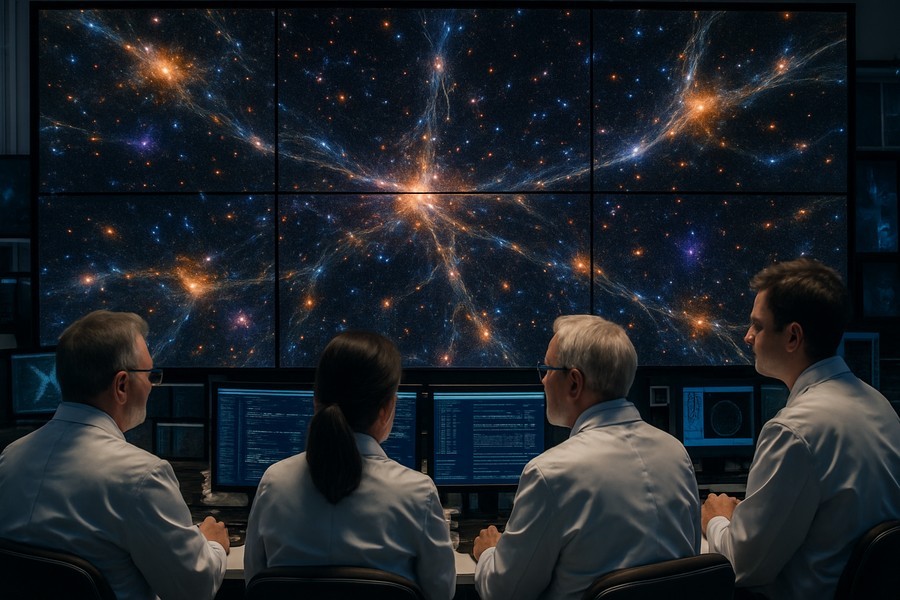
Speeding Up Space Exploration with Equal Precision
Picture a galaxy. Now, realize that compared to the vastness of the universe, that galaxy is but a tiny speck. Along with countless other specks, they form clusters which join together into superclusters. These superclusters then weave into filaments filled with voids, creating a massive 3D framework that is our universe.
Understanding or even visualizing something of such magnitude is no easy task. Scientists utilize the principles of universe physics and data gathered from astronomical tools to construct theoretical models. These models are designed to statistically depict the "cosmic web" and facilitate the estimation of its key parameters.
Challenges of Utilizing Theoretical Models
However, these models require a significant amount of time and computational power. With the astronomical data available to us expanding rapidly, there is a need for more efficient analysis methods without sacrificing accuracy. That's where emulators come in. These devices mimic the responses of the models but operate at a much quicker pace.
But does this faster route risk a decline in precision?
Introducing a New Emulator
A group of scientists from various international institutions have designed and tested an emulator named Effort.jl. Their research, published in the Journal of Cosmology and Astroparticle Physics, demonstrates that Effort.jl provides results with virtually the same accuracy as the model it emulates. Impressively, it can do so within minutes on a standard laptop, as opposed to requiring a supercomputer.
"Consider trying to examine the contents of a glass of water down to its microscopic components, individual atoms, or even smaller," explains Marco Bonici, one of the researchers involved in the study. "While it's theoretically possible, the number of calculations required to detail what happens when the water moves is overwhelming."
But by encoding certain properties at the microscopic level, their effect at the macroscopic level, such as the water's movement, can be observed. This is what an effective field theory does. It's akin to the theoretical models, where the water represents the universe on a grand scale, and the microscopic components symbolize small-scale physical processes.
How Emulators Aid in Data Analysis
The astronomical observations are fed into a code that calculates a "prediction," but this process requires considerable time and computation. Given the volume of data currently available—and what is expected from ongoing or forthcoming surveys—it's not feasible to implement this process exhaustively each time.
"This is why we now rely on emulators like ours, which can significantly reduce time and resources," Bonici adds.
An emulator essentially replicates the function of the model through a neural network that learns to correlate the input parameters with the model's pre-calculated predictions. After being trained on the model's outputs, the network can generalize to combinations of parameters it hasn't seen before. Despite not "understanding" the physics, the emulator knows the theoretical model's responses and can predict what it would output for a new input.
Efficiency of Effort.jl
What sets Effort.jl apart is its ability to further reduce the training phase by incorporating existing knowledge about how predictions vary when parameters change. Instead of forcing the network to "re-learn" these variations, the emulator utilizes them from the outset.
Effort.jl also employs gradients, or "how much and in which direction" predictions alter if a parameter is slightly adjusted. This feature enables the emulator to learn from fewer examples, thus reducing computational needs and enabling it to function on smaller machines.
Validating the Accuracy of Effort.jl
Of course, a tool like this requires thorough validation. If the emulator doesn't comprehend the physics, how can we be certain that its shortcuts produce accurate results? The research study addresses this very question, demonstrating that the accuracy of Effort.jl—on both simulated and real data—closely aligns with the model.
"In some instances, where parts of the analysis had to be omitted to expedite the process with the model, Effort.jl enabled us to re-integrate those missing elements," Bonici concludes.
Therefore, Effort.jl serves as a crucial tool for analyzing forthcoming data from experiments that promise to enhance our understanding of the universe on a grand scale.
